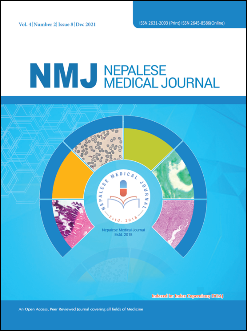Histopathological Examination in the Categorization of fungal Rhinosinusitis - a Retrospective Study
DOI:
https://doi.org/10.3126/nmj.v4i2.41377Keywords:
Fungal ball, Fungus, Grocott methenamine silver, RhinosinusitisAbstract
Introduction: Fungal Rhinosinusitis is broadly defined as any sinonasal pathology related to the presence of fungi and is increasingly recognized worldwide. This study aimed to assess and ascertain the need for histopathological examination in the management of fungal Rhinosinusitis.
Materials and Methods: This study was performed over two years, from April 2019 to April 2021, in the Department of Pathology, Vinayaka Missions KirupanandaVariyar Medical College and Hospital, Salem. A total of 383 cases of rhinosinusitis/nasal polyps were studied. Histopathological examination and categorization were done and compared with clinical diagnosis.
Results: Only 4/18 cases of acute fungal Rhinosinusitis were correctly diagnosed(22.22%). Nineteen cases of the fungal ball were diagnosed, but none was correctly categorized. Clinical suspicion of fungal sinusitis was present in 10 cases of Rhinosinusitis, which turned out to be chronic Rhinosinusitis in histopathology. In AFRS, fungal elements were overlooked in Hematoxylin and Eosin stained slides and identified only by Grocottmethenamine silver in one-fourth of the cases.
Conclusions: Though clinical diagnosis was made in 86% of fungal rhinosinusitis cases, correct categorization was done only in one-third of cases. CT scan could diagnose 60% of cases, but none was categorized. As treatment depends on the type of fungal Rhinosinusitis, histopathological examination is the gold standard for diagnosing and treating fungal Rhinosinusitis.
Downloads
Downloads
Published
How to Cite
Issue
Section
License
Copyright (c) 2021 Sangeetha Kandasamy, Megala Chandrasekar, Thamilselvi Ramachadran

This work is licensed under a Creative Commons Attribution 4.0 International License.
This license enables reusers to distribute, remix, adapt, and build upon the material in any medium or format, so long as attribution is given to the creator. The license allows for commercial use.
Copyright on any article published by Nepalese Medical Journal is retained by the author(s).
Authors grant Nepalese Medical Journal a license to publish the article and identify itself as the original publisher.
Authors also grant any third party the right to use the article freely as long as its integrity is maintained and its original authors, citation details and publisher are identified.




